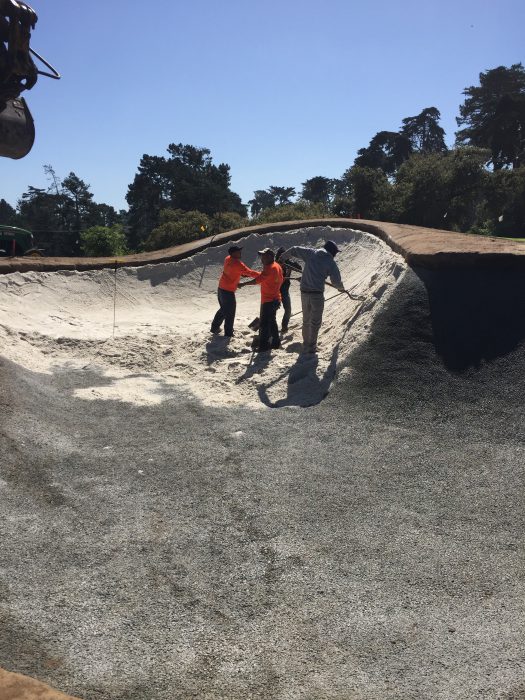‘Washout’ bunkers – is there a cheaper alternative?
Repairing a damaged bunker after heavy rainfall is expensive and time-consuming. Richard Allen believes this is a problem that is going to get worse but there is a cost effective way to solve it – and it begins by understanding why bunkers suffer ‘washout’

The revetted edge at Bloxwich Golf Club. If high and steep sand faces are essential, then an appropriate liner should be selected. It is still risky to go steeper than 30 degrees with most types of sand
Rain. More precisely ‘heavy rain’ has been the centre of my attention for over 28 years as a civil engineer, specialising in drainage and flood defence design. For the past seven years, as I have adjusted my career to serve the golf sector, I have found the knowledge I gained to be very useful, particularly in the field of bunker design and construction.
One of the most physically demanding and frustrating jobs for the modern-day greenkeeper is the repair of damage to bunkers after heavy rainfall. A quick trawl through relevant discussion groups on social media will clearly demonstrate this phenomenon. The same searches will also reveal the increasing array of products which claim to have all the answers. Most of these products would represent a significant investment for golf clubs, so it is well worth examining the likely causes before looking for solutions.
What is bunker washout? It sounds simple and it is, with a little explanation of basic soil mechanics. Dry sand, due to the friction between the rough surfaces of the individual sand grains, can usually stay stable on slopes of up to 30 to 35 degrees. Damp sand, where there is some moisture in the voids between the grains, can be even more stable. The adhesive forces caused by water molecules add more stability. The Olympic Club in San Francisco has bunkers with sand sloping at an incredible 60 degrees, due to dampness introduced by the liner (in this instance Capillary Concrete) and sub surface drip lines. When however, the inter particle voids become completely full of water, all the friction between adjacent sand grains is lost, and the sand turns into a mobile liquid, quickly flowing downhill, resulting in the familiar rivulet patterns seen on bunker washouts. The sand voids become full of water when the intensity of rainfall exceeds the rate at which the sand can drain, or when the terrain around the bunker sheds surface water flow across the bunker edge and onto the sand.

Washout on one bunker at Potters Bar GC after 43mm of rain in six hours
The impact of washout is not simply the hard work and man hours needed to replace the sand onto steep slopes. If the rainfall is particularly heavy and continues after an unprotected sub-soil is exposed, fine silts and stones can be mobilised, which then flow, mixing with the bunker sand. After a few cycles, the sand can become so contaminated that it is unsuitable and has to be replaced at additional cost. With many sand quarries now exhausted in the UK and abroad, bunker sand is not going to be getting any cheaper. Granted, the sand expense is a concern, but are there any other reasons why and how golf clubs should be taking a close interest in washout issues? In my opinion there are three more very good reasons, which I have listed in my order of importance:
- Increasing frequency of short, high intensity rainfall events,
- The modern (‘retro’) design philosophy demanding increasingly visible sand faces and
- Golfers’ expectations.
Increasing frequency of high intensity rainfall events
‘It’s a well-known scientific principle that warmer air holds more water vapour,’ wrote John Abraham in the guardian earlier this year. ‘As the earth warms, as long as there is a source for evaporation, increasingly heavy rainfall is a certainty’. In order to design any surface water drainage network it is important to understand rainfall patterns and predict pipe flows for a range of ‘design rainfall events’. I learned how to calculate from first principles (unfortunately my career started before computer aided methods!), for example, that if 18mm of rain fell in one hour in Merthyr Tydfil, that was a five-year return period. However more recently it has become apparent that the data gathered over the past decades and meticulously documented in design guidance by HR Wallingford and others, to predict rainfall intensity, is now almost certainly out of date. As a ‘stop-gap’ measure, for example, the Environment Agency recommends that calculated flood predictions are increased by 20 per cent to cater for the effects of climate change.

How the EcoBunker at Potters Bar GC looked at the same time of the washout in the above image
My experience of bunker washouts is a case in point. All of us know that in the hotter parts of the world rain can fall with incredible intensity. As a result, golf course construction (including bunkers) is quite different in Florida and other similar areas compared to the UK. But what happens if high intensity rainfall becomes more common in the UK? On our website is a video taken at Potters Bar GC, where I visited, by chance after a heavy downpour during the previous night. Approximately 43mm of rain fell in six hours. This was roughly a once-in-every-three-years event. The trouble is that the club claims it is getting similar rainfall events, three or four times each year, requiring major repair work each time. This illustrates something that I think a lot of those involved in golf maintenance have noticed: The frequency of high intensity rainfall events in the UK is certainly increasing. If this is the trend, then bunker maintenance will become more difficult and more expensive in the future, unless appropriate resilient design measures are put in place.

Sixty degree slopes at Olympic GC in San Francisco
‘Retro’ bunker design
I’m a fan of the courses designed by Mackenzie, Colt and what has become known as ‘Golden Age’ architecture. Many of the architects of that era, in their bunker strategies, strove for highly visible, natural looking bunkers. There are plenty of beautiful old photographs circulating on Facebook and Twitter. We have all seen recently some very exciting bunker restoration projects with the trademark elaborate edging and dramatic high sand faces. I am sure that in every instance an appropriate specification and design has been used, but my concern is that if this relatively expensive design trend continues, some golf clubs, not blessed with high budgets may be tempted to ‘cut corners’ and regret their decision later.
It’s worth remembering that rainfall patterns were different in the 1920s compared to today. We know this. We have the records. We know that climate was cooler in the UK and scientists will agree that cooler air cannot hold as much moisture. Therefore, high intensity rain and bunker washouts were less common.
Furthermore, there was better availability of cheap and willing labour in those days, so bunker repair was easier. One more point: it’s widely accepted that golfers’ expectations were different then.

Raised edges at Chart Hills Golf Club. The introduction of better defined resilient edges gives the opportunity to subtly reshape the terrain around bunkers and direct surface water flows around the bunker, rather than into it
Golfers’ expectations
Like it or not, most golfers today expect consistent sand, good lies in bunkers and the ability to play straight at the flag. As all those involved in maintenance will know, this is extremely difficult and expensive to deliver. With the pressure on golf courses to retain members and attract more visiting income, it would be a very brave golf club that took a ‘take it or leave it’ approach to bunker conditioning.
Alternatives
I will conclude this article on a positive note by suggesting a few cost-effective design measures based upon what I’ve learned over the past few years.
Firstly, if high and steep sand faces are essential, then an appropriate liner should be selected. There are several good products on the market, but even with liners in place, unless you have extra measures in place (such as drip lines) it is very risky to go steeper than 30 degrees with most types of sand.
Secondly, why not consider reducing the maximum slope on the sand to 15 or 20 degrees? This can be very easily done by increasing the face height of the bunker to 300, 400, 500mm or more. This is a highly effective method, and courses where we have done this, for example Potters Bar, Royal Winchester, Chart Hills and Druids Heath (to name but a few) have seen washout eliminated on those bunkers. This can be done sensitively using revetting, and to add to resilience we recommend synthetic turf. There are some purists who dislike revetting away from the classic seaside environment, but I disagree. When installed with sensitivity these features can add great value to all types of golf course.

Revetted edges at Druids Heath Golf Club
Thirdly, the introduction of better defined resilient edges also gives the opportunity to subtly reshape the terrain around bunkers and direct surface water flows around the bunker rather than into it.
Golf is responding to the challenge of washouts (and climate change in general) and it has been really exciting for me to see how the industry does give innovation and new ideas a fair chance.
Richard Allen is the CEO of EcoBunker















Let me tell You a sad story ! There are no comments yet, but You can be first one to comment this article.
Write a comment